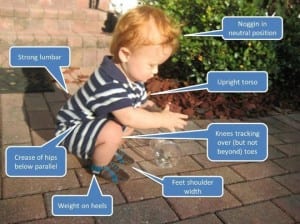How to do a perfect squat
A sound functional squat is something that you will discover is not only essential to every athlete but in fact every human-being must demonstrate in order to be healthy and pain-free. The squat is no more an invention of a trainer or coach than is walking or running. It is a vital, natural, and a functional component of your well-being.
Most of the planet’s inhabitants do not sit in chairs; they squat. Meals, defecation, and gatherings are all performed in a squat position and never in chairs. Only in the modern world do we find ourselves sitting in chairs, couches, benches and stools. This comes at a loss of functionality due to the degeneration and de-conditioning of bone, joints, soft tissue, and muscle. If you think about it, if the human species was intended to spend so much time sitting we would have been given 4 legs attached to our backsides instead of 2.
Occasionally there are athletic trainers, health-care providers, or physical therapists that say that you should not squat. In nearly every instance this is pure ignorance on the part of the practitioner. A question that should be asked to these individuals is “by what method should your patient get off the toilet?”
In a similarly misinformed manner you may have heard that the knees should not be bent past 90 degrees in a squat. This is an argument that is quickly resolved when asking that person to sit on the floor with their legs out in front of them and then stand without bending their legs past 90 degrees. Without getting on their feet in some awkward manner they will never get off the floor in a functional manner without bending at least one knee past 90 degrees.
Not only is the squat not detrimental to the knees, when done correctly it is actually rehabilitative of painful, damaged, or delicate knees. In fact, if you do not squat properly, your knees cannot stay healthy regardless of how free of pain or discomfort you are. This is equally true of the hips and back.
On an athletic front, the squat produces solid core strength and it is the ultimate hip extension exercise. Since powerful and controlled hip extension is the foundation of all good human movement and elite athleticism it should be the cornerstone of everyone’s training.
It is entirely possible to injure yourself by squatting incorrectly, but it is also very simple to bring the squat to a level of safety matched by walking.
Here’s how it’s done:
Start with your feet shoulder width apart and the toes pointed slightly outwards. When ready to squat, you must keep your mid-section tight by contracting abdominal muscles and accentuating the normal arch in the low back. The movement is initiated by sending your butt back just as if you were going to bump a car door closed with your rear if your hands were full. Descend by sinking into the squat being mindful of keeping your body weight in your heels so that the knees do not extend past the toes. Lift your arms for counterbalance and keep your chest tall as you descend while maintaining a tight midsection, being careful not to surrender the arch in your low back. Stop as low as you can, preferably so that the fold of the hips descends past the knees, and make sure your knees stay pressed outwards and not caving inwards. Upon rising exert your force to the outside of your feet as if you were trying to rip a piece of paper between your feet. Stand tall at the top of your squat to complete your full hip extension.



